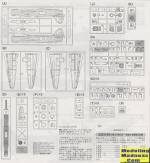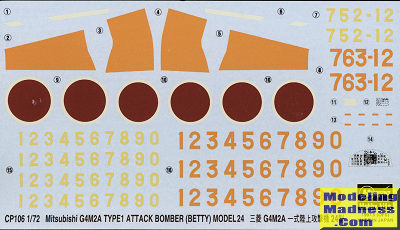
Hasegawa 1/72 G4M2a Model 24
| KIT #: | 51266 (CP106) |
| PRICE: | 2800 yen when new |
| DECALS: | Any aircraft from one of two units |
| REVIEWER: | Scott Van Aken |
| NOTES: | 1997 boxing |

| HISTORY |
| THE KIT |
 One
of Hasegawa's earliest kits was the initial G4M1 'Betty' bomber. It was back
when their kits had all raised detail and the plastic was very thick. It
also had minimal interior detailing, but made into a nice representation of
this important Japanese bomber.
One
of Hasegawa's earliest kits was the initial G4M1 'Betty' bomber. It was back
when their kits had all raised detail and the plastic was very thick. It
also had minimal interior detailing, but made into a nice representation of
this important Japanese bomber.
Fast forward about 25-30 years to the late 1990s and we find Hasegawa in the midst of a major program of newly tooled kits that includes just about all Japanese WWII twins of all sizes. That includes this one. Doing the later G4Ms required a new tool and so we have one.
You get a fairly nice interior that has a lot more detail than what the previous kit offered. There are crew stations throughout the airframe and that includes various bulkheads and crew equipment. Hasegawa provides the option to have the side guns either deployed or stowed. Both the nose and tail section are separate since they are mostly clear so a masking set is highly recommeneded. The dorsal turret is trapped between the fuselage halves so that will need to be masked and painted prior to installation so it can be properly covered when the rest of the airframe is painted.
Wings are upper and lower halves with no real main gear well detail, but in this scale that isn't that much of an issue. The main gear is fairly complex and it appears that it has to be installed prior to attaching the rest of the gear nacelle. Test fitting during construction will prove if this is true or not.
You have the option of a large radar antenna on the nose if you want to do that unit's planes. Weapons options are a pair of large bombs or a torpedo. The bomb bay dors can be posed open or closed as you wish. One thing I noticed were the large armor patches covering the underside of the wing fuel tanks.
 Instructions
are well done with the usual Gunze paint references. There are two units
provided, both in Mitsubishi green over light grey. The wing ID bands are
provided as decals and you have alternate numbers for both units so you are not
limited to a single aircraft per unit. Japanese naval aircraft are generally
rather boring in that they don't have fancy camouflage schemes. Decals are
nicely done and should work fine. I'd suggest hot water to get the best
performance.
Instructions
are well done with the usual Gunze paint references. There are two units
provided, both in Mitsubishi green over light grey. The wing ID bands are
provided as decals and you have alternate numbers for both units so you are not
limited to a single aircraft per unit. Japanese naval aircraft are generally
rather boring in that they don't have fancy camouflage schemes. Decals are
nicely done and should work fine. I'd suggest hot water to get the best
performance.
| CONCLUSIONS |
| REFERENCES |
https://en.wikipedia.org/wiki/Mitsubishi_G4M
September 2020
Back to the Main Page Back to the Previews Index Page
Back to the Previews Index Page